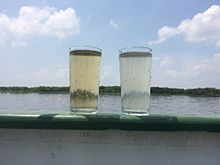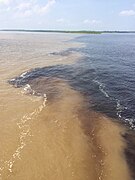Waters

In nature, a body of water is flowing or standing water . It is integrated into the natural water cycle.
The study of surface waters is hydrology , divided into limnology (inland water science ) and oceanography ( sea science ). The study of the underground waters is hydrogeology .
Components
According to DIN 4049, a body of water consists of the body of water (the water volume itself), the water bed (the enclosure of the water from the bed and the bank) and the associated aquifer .
Types of water
There are different criteria for the classification of waters. A classic division is that of seas ( salt water ) and inland water and ground water ( fresh water ). With the multitude of water types, there are numerous border and transition forms.
After main and backwaters
According to the position of the water body

Waters can lie above the earth ( surface water ) or underground ( groundwater ).
Groundwater as an underground body of water usually occurs as a coherent body of water in the system of gaps in the ground , of unconsolidated rock , or in crevices and crevices of sheared solid rock. For information on the aquifer that conducts the aquifer, see aquifer . Water in completely water-filled caves (see phreatic cave ) is counted as groundwater.
A spring is a connection between underground water and surface water. The opposite of a source is the shrinkage , there surface water disappears into the subsurface.
A body of water is referred to as receiving water if its technical function of being the point of introduction for drainage , especially of sewage , is in the focus.
According to position in the water system
In hydrogeography, a distinction is made between different types of inland waters and seas according to their position in the water system and the extent of the water body .
Inland waters
A distinction is made between flowing water and still water (standing water), which can be above or below ground. There are naturally formed and artificial inland waters.
Above-ground running waters (see also river ordinal number and type of running water ):
- Stream , very large flowing water that flows into a sea
- River , large flowing water
- Stream , small flowing water (see also channels )
- Canal , transport structures (artificial waters). Most shipping canals consist of a chain of barrages and, apart from the lock current, are actually still water.
Underground rivers:
- Cave river, flowing water in a water cave
- Cleft water
- large-scale water supply and disposal structures (artificial bodies of water)
Above-ground still waters:

- Lake , larger accumulation of water
- Reservoir (artificial waters)
- Pond , small and moderately deep, with no inflow or outflow
- Pond , small and moderately deep, with inflow and outflow (artificial water)
- Pond , drying up regularly
- Puddle , short-term standing water
Underground still waters:
Most natural bodies of water ultimately drain into the sea (see exorheic flow ). Otherwise it is endorheic waters.
Seas
Seas are the interconnected standing waters of the earth that surround the land masses. The largest seas are the oceans .
A secondary sea is more or less separated from the open sea:
- Marginal sea , separation by island chains or sea thresholds
- Mediterranean Sea , separation by island chains, mainland or sea thresholds
- Inland sea , connection through a strait
Sea areas close to the mainland are called coastal waters .
According to the flow behavior
The hydrodynamics fundamentally different flume (flowing water) and flow-free waters, see also dead water (still water).
A distinction is made between channels:
- Currents in open channels (comparable currents can also occur in still waters)
- Currents in closed channels , e.g. B. in phreatic cave systems or pressure tunnels of hydropower plants
- Seepage currents
Circulation types of still waters:
- amictic (no mixing)
- meromictic (not complete mixing)
- holomictic (complete mixing)
According to water flow over time
Perennial waters ( Latin perennis , `` all year round '') are surface waters or springs that carry water all year round.
Intermittent waters ( intermittent 'interrupt') sometimes fall dry, such as active water caves and occasionally drying up springs (see source of hunger ). Further distinction:
- Periodic waters (Greek-Latin, períodos '[regular] walking around') carry water in a regular cycle, for example ponds, channels of snowmelt , meltwater lakes or bodies of water that are under the influence of the tides ( brackish water , backwater areas)
- Episodic bodies of water (Greek-Latin, 'temporarily') only occasionally carry water, for example bodies of water that form after rainfall (overflows from marshland and bog areas ), natural and technical receiving waters ; those that only have short-term water ( puddles , wadi , rivers ) are also referred to as ephemeral waters (Greek-Latin, fleeting, transient).
According to nutritional content
In the trophic system of ecology, four trophic levels are distinguished:
- oligotrophic (low nutrient content)
- mesotrophic (medium nutrient content)
- eutrophic (high nutrient content)
- hypertrophic (excessive nutrient content)
Regional water types
In addition, there are regional water body types that are determined according to various, non-generalizable characteristics and can coincide with general water body types. The regional water types in southwest Germany include the Gießen of the Upper Rhine region and the blades , and in northwest Germany the Bracks , Fleete and Wetterungen .
In water law
The terms used in water law are largely based on those in the natural sciences, but are not always congruent and can be subject to historical change. The German Water Resources Act (WHG) includes bodies of water above ground, groundwater , coastal waters and marine waters as well as small bodies of water such as side ditches as part of roads, irrigation and drainage ditches or healing springs, regardless of whether it is a natural or artificial body of water is, flows or stands in a bed, is channeled underground in parts or flows wildly from a spring.
Ecological condition
In the European Union (EU) according to Directive 2000/60 / EC (EU Water Framework Directive, WFD), the ecological status of rivers and surface waters (such as groundwater ) is analyzed according to various criteria and classified according to five grades: “very good “,“ Good ”,“ moderate ”,“ unsatisfactory ”,“ bad ”.
According to a report by the European Environment Agency published in 2018, two thirds of Europe's waters are not in good ecological status. In many small streams , strong pesticide loads are measured again and again, which in some cases far exceed the permitted limit values.
Color of waters

The pure water of a nutrient-poor, phytoplankton- poor body of water absorbs the short-wave ultraviolet and violet as well as the long-wave red spectral components of the incident light with increasing depth , so that the water appears bluish. In contrast, more nutrient-rich waters with phytoplankton appear greenish. On the other hand, calcareous waters, such as limestone lakes and partly the Alpine runoff, have a green to turquoise effect due to the calcium content.
Dissolved and suspended substances ( suspended matter ) such as iron and manganese compounds or humic substances cause a water body to turn brown and often reduce its transparency. In particular, iron (III) oxide hydrates (iron ocher) settle as a brownish precipitate, so they do not color the water, but rather the water bed. Iron compounds are also responsible for the red coloration of the “bloodstream” of the Antarctic Blood Falls .
Waters that carry suspended matter from clayey-silty limestone, loess or loam appear cloudy. The easiest way to tell the difference is where water with low and high levels of suspended matter converges, such as in the upper reaches of the Rhine.
In the tropics there are three main types: black water river (dark cloudy), white water river (light cloudy) and clear water river .
Front and rear Rhine
Confluence of the Alaknanda and Bhagirathi at Devprayag to the Ganges
See also
literature
- Albert Baumgartner, Hans-Jürgen Liebscher: General hydrology, quantitative hydrology. 2nd Edition. Borntraeger, Berlin 1996, ISBN 3-443-30002-2 (textbook of hydrology 1).
- Siegfried Dyck (Ed.): Applied hydrology. Ernst, Berlin 1976.
- Siegfried Dyck, Gerd Peschke: Fundamentals of hydrology. 3. Edition. Verlag für Bauwesen, Berlin 1995, ISBN 3-345-00586-7 .
- Hubert Hellmann: Qualitative hydrology. Borntraeger, Berlin 1999, ISBN 3-443-30003-0 (Textbook of Hydrology 2).
- Ulrich Maniak: hydrology and water management. 5th edition. Springer, Berlin 2005, ISBN 3-540-20091-6 .
Web links
Individual evidence
- ↑ DIN 4049 part 1 no.1.10.
- ↑ ephemeral waters . In: Lexikon der Biologie , Spektrum-Verlag; Retrieved November 9, 2017.
- ^ Richard Pott, Dominique Remy: Gewässer des Binnenlandes , Stuttgart 2000, p. 125. ISBN 3-8001-3157-9
- ↑ §§ 2 and 3 WHG
- ↑ Environmental goals - the good condition for our waters, bmnt.gv.at. Retrieved April 4, 2018 .
- ^ Sibylle Wilke: Ecological condition of flowing waters . In: Federal Environment Agency . October 18, 2013 ( Umweltbundesamt.de [accessed April 4, 2018]).
- ↑ Europe's waters in poor condition orf.at
- ↑ EEA Report No 7/2018 eea.europa.eu, accessed on May 2, 2019.
- ↑ Jorge Casado, Kevin Brigden, David Santillo, Paul Johnston: Screening of pesticides and veterinary drugs in small streams in the European Union by liquid chromatography high resolution mass spectrometry. In: Science of The Total Environment. 670, 2019, p. 1204, doi : 10.1016 / j.scitotenv.2019.03.207 .
- ↑ Andri Bryner: Too many pesticides in small streams. In: eawag.ch . April 2, 2019, accessed May 2, 2019 .
- ^ Richard Pott , Dominique Remy: Gewässer des Binnenlandes , Stuttgart 2000, pp. 55 and 47 ff. ISBN 3-8001-3157-9 .
- ^ Richard Pott, Dominique Remy: Waters of the inland . Stuttgart 2000, p. 131. ISBN 3-8001-3157-9 .







